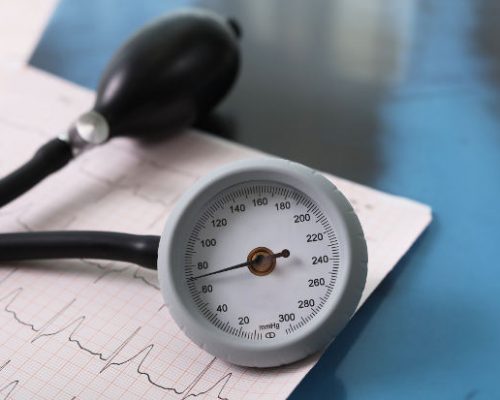Know the Normal Values of Arterial Pressure
The arterial tension considered “ideal” is 119/79 mm/Hg. However, the truth is that the normal arterial pressure has a higher range than this one.
For instance, it’s considered systolic arterial hypertension when the tension is higher than 140/90 mm/Hg, which is the same as 140 mm/Hg systolic pressure and 90 mm/Hg diastolic pressure.
On the other side, it’s arterial hypotension if the tension is inferior to 100/60 mm/Hg, which means, 110 mm/Hg of systolic pressure and 60 mm/Hg or diastolic pressure.
The measure of arterial pressure is a routine act that we can carry to prove we don’t suffer from any health problem related with an arterial pressure deficit. These could be arterial hypertension (high tension) or arterial hypotension (low tension), others.
For this reason, it’s important to know how to measure tension. Similarly, it’s vital to understand this measure results. So, keep on reading and you’ll find out which are the normal values of arterial pressure.
Which Are the Factors You Must Consider When Measuring Arterial Tension?
To know the normal arterial pressure values, it’s important to highlight that there are many factors that influence arterial pressure values on each individual; for instance age, sex, habits, alimentation, etc.
Besides, there are other variants on the moment of the arterial pressure measure like effort, digestion, emotions, stimulants, sleep, and other factors.
It’s because all of these circumstances – along with many others – that the numbers have relative reliability and must be oneself with the study of all the factors that intervene. Even so, there have established normal tension values, in which and considering a spacious margin, arterial pressure is considered correct.
What Do the Values Show?
 To know if your arterial pressure is normal, it’s important to know what show every value. For instance, the first value will be indicated on the mercurial scale. Consequently, this will show the maximum blood pressure on the arterial net, which corresponds to the ventricle contraction or systole of our heart.
To know if your arterial pressure is normal, it’s important to know what show every value. For instance, the first value will be indicated on the mercurial scale. Consequently, this will show the maximum blood pressure on the arterial net, which corresponds to the ventricle contraction or systole of our heart.
Alternatively, the second number will show the minimum blood pressure on arteries, diastolic pressure, which corresponds to the maximum ventricle relaxing.
In most countries, arterial tension is expressed on mercurial millimeters (mm/Hg)
Normal Values of Arterial Tension
Considered normal arterial tension values are:
- A systolic pressure between 100 and 140 mm/Hg
- Diastolic pressure between 60 and 90 mm/Hg
Therefore, you have a normal pressure if you’re between these values. In addition, it’s recommendable to ha a systolic pressure that doesn’t go over 120 mm or 130 mm maximum. Similarly, the diastolic must be under 90 mm/Hg
 Moreover, when aging, pressure tends to elevate, because blood vessels lose elasticity. As a result, normal values of arterial pressure are higher on old adults.
Moreover, when aging, pressure tends to elevate, because blood vessels lose elasticity. As a result, normal values of arterial pressure are higher on old adults.
There’s hypertension or high tension when values go over 140 /90 mm/Hg, while values under 100/60 mm/Hg show hypotension or low tension.
Normal Values of Arterial Tension According the Age
Like it has been said, normal values of normal tension can vary according the age and sex too. So, it’s suitable to know which the numbers are in every particular case. Take note:
16 to 18 years
- Systolic pressure: 105 – 135 (men) / 100 – 130 (women)
- Diastolic pressure: 60 – 80 (men) / 60 – 85 (women)
19 to 24 years
- Systolic pressure: 105 – 139 (men) / 100 – 130 (women)
- Diastolic pressure: 62 – 88 (men) / 60 – 85 (women)
25 to 29 years
- Systolic pressure: 108 – 139 (men) / 102 – 135 (women)
- Diastolic pressure: 65 – 89 (men) / 60 – 86 (women)
30 to 39 years
- Systolic pressure: 110 – 145 (men) / 105 – 139 (women)
- Diastolic pressure: 68 – 92 (men) / 65 – 89 (women)
40 to 49 years
- Systolic pressure: 110 – 150 (men) / 105 – 150 (women)
- Diastolic pressure: 70 – 96 (men) / 65 – 96 (women)
50 to 59 years
- Systolic pressure: 115 – 155 (men) / 110 – 155 (women)
- Diastolic pressure: 70 – 98 (men) / 70 – 98 (women)
60 years or more
- Systolic pressure: 115 – 160 (men) / 115 – 160 (women)
- Diastolic pressure: 70 – 100 (men) / 70 – 100 (women)
All this information is the normal pressure of a person in the corresponding age range. On the contrary, if the values are out of these ranges, the best is to consult your doctor.
The Importance of Having a Good Arterial Tension
Arterial pressure is the strength our blood flows through our body. For this reason, it’s important to keep the correct values to guarantee your cardiac health.
High arterial tension is a very common illness that puts in risk the heart’s health. As a result, you’ll be more alike to suffer from cardiac diseases. Therefore, carrying a healthy lifestyle and taking the correct medication indicated by a specialist, is fundamental to improve this.
Similarly, a low arterial tension, a less common condition, can cause serious circulation issues, frequent blackouts, and conscience loss. So, knowing how to act in front of a tension low and caring about your alimentation is vital to guarantee our wellbeing.
Recommedations
 Remember that if when measuring your tension the values don’t match with the normal ones, which is usually known as discomposed arterial tension, it’s important to consult a specialist to be checked.
Remember that if when measuring your tension the values don’t match with the normal ones, which is usually known as discomposed arterial tension, it’s important to consult a specialist to be checked.
Taking care of your arterial tension is the same as taking care of your heart’s health. For this reason, it’s important to pay attention to this aspect.
Find more tips on our website.




